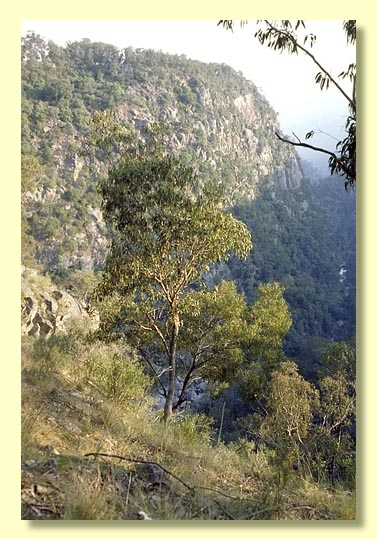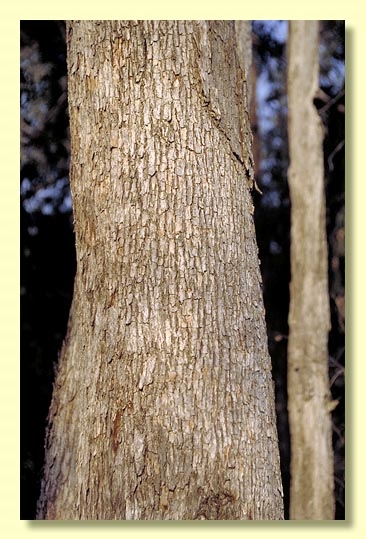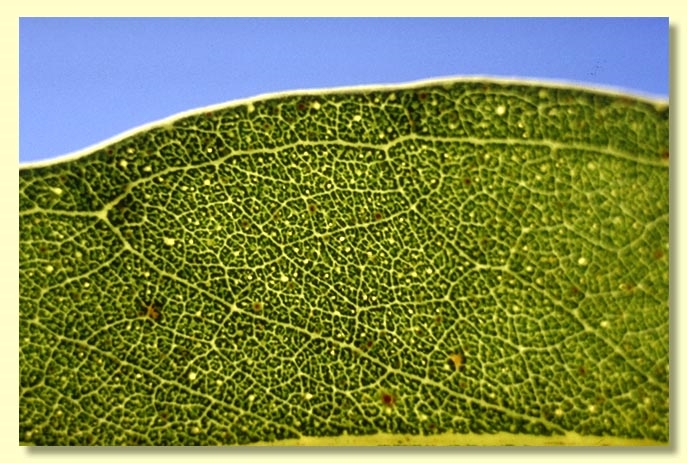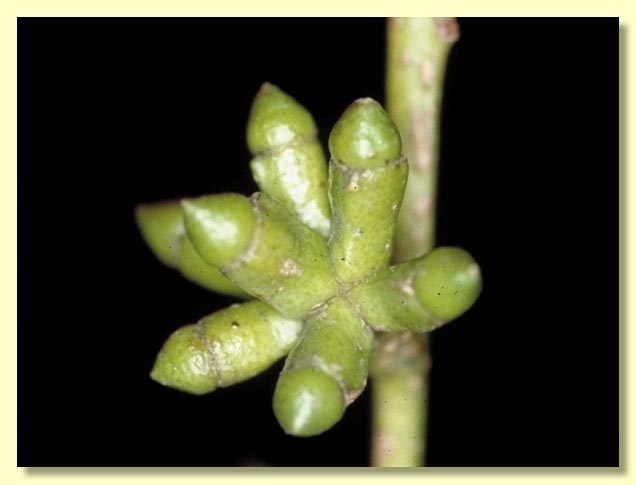Euclid - Online edition
Eucalyptus retinens
Eucalyptus | Symphyomyrtus | Maidenaria | Euryotae | Globulares | Remanentes
T: NSW, Northern Tablelands, Dyamberin Station, Connaughtmans Creek area, c. 15 miles (24 km) NW of Ebor, 2 Aug. 1954, R.J.Turner 11; holo: NSW 182117.
Bark rough on trunk and larger limbs, box-type, grey, smooth bark grey to green, pink or coppery.
Juvenile growth (coppice or field seedlings to 50 cm): stem square in cross-section, sometimes winged, smooth or warty; juvenile leaves opposite and sessile for many pairs, orbicular to ovate or broadly lanceolate, 3.5–10 cm long, 2.5–8 cm wide, amplexicaul, apex rounded or pointed, margin entire or crenulate, glossy and green or dull, grey-green or slightly glaucous.
Adult leaves alternate, petiole 1.2–4 cm long; blade lanceolate to falcate, 9–30 cm long, 1–4 cm wide, base tapering to petiole, concolorous, glossy, green, side-veins at an acute or wider angle to midrib, densely reticulate, intramarginal vein parallel to and well removed from margin, oil glands intersectional and island.
Inflorescence axillary unbranched, peduncles 0.5–1.7 cm long, often flattened, buds 7 per umbel, sessile or on pedicels to 0.5 cm long. Mature buds obovoid to oblong, often slightly angled longitudinally, 0.7–1 cm long, 0.3–0.5 cm wide, scar present, operculum rounded or conical, stamens irregularly flexed, anthers cuboid to oblong, versatile, dorsifixed, dehiscing by longitudinal slits (non-confluent), style long, stigma blunt, locules 3 or 4, the placentae each with 4 vertical ovule rows. Flowers white.
Fruit sessile or with pedicels to 0.4 cm long, cup-shaped to cylindrical or barrel-shaped, 0.5–1 cm long, 0.7–1 cm wide, sometimes slightly angled longitudinally, disc raised-convex to annular, valves 3 or 4, exserted.
Seeds black, 2–2.7 mm long, ovoid or flattened-ovoid, often pointed at one end, dorsal surface shallowly pitted, hilum ventral.
Cultivated seedlings (measured at ca node 10): cotyledons bilobed to oblong; stems usually square in cross-section, sometimes winged also, non-glaucous; leaves sessile and opposite for at least 13 nodes, orbicular to cordate, 4–11 cm long, 2.5–7. cm wide, amplexicaul or the base rounded, slightly discolorous, mid-green above and paler beneath.
Flowering time not known.
A tree of the Northern Tablelands of New South Wales, occurring at the heads of gorges of the Macleay and southern Clarence River systems, usually growing at the edge of steep ridges; also recorded from Stewarts Brook State Forest, Barrington Tops. Characterised by its rough persistent box bark, its sessile or shortly pedicellate angled buds and the glossy green juvenile leaves. E. retinens must be very closely related to E. cypellocarpa and E. goniocalyx. It is also related to E. cypellocarpa of eastern New South Wales and southern Victoria, which is a tall forest tree with smooth bark compared to the smaller tree with rough bark of E. retinens. All related species, including E. alaticaulis, have the characteristic elongated bud with a longitudinal angle and the operculum much shorter than the hypanthium.
Also closely related is E. volcanica, a species (according to the original description) from areas further west of E. retinens in the Nandewar and the Warrumbungle Ranges. It differs slightly from E. retinens by its pedicellate buds and fruit and by its glaucous juvenile leaves. Its occurrence in the Nandewar Range is uncertain, as juvenile collections from Mt Kaputar have shown to be non-glaucous and look very similar to those of E. retinens.
Eucalyptus retinens belongs in Eucalyptus subgenus Symphyomyrtus section Maidenaria, a large group of species more or less restricted to south-eastern Australia, characterised by bilobed cotyledons, simple axillary inflorescences, buds with two opercula, stamens with versatile anthers and flattened seeds with a ventral hilum. Within this section, E. retinens belongs in series Globulares subseries Remanentes, having sessile, juvenile leaves opposite for many pairs, small buds in clusters of seven and small fruit.
The relationship between E. retinens, E. volcanica, E. cypellocarpa (including the synonymized E. alaticaulis, E. quinniorum, E. oresbia and E. pyrenea), and E. litoralis needs further investigation.













